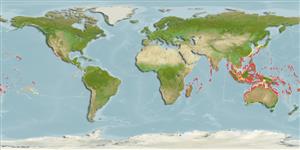>
Blenniiformes (Blennies) >
Tripterygiidae (Triplefin blennies) > Tripterygiinae
Etymology: Helcogramma: Greek, helkos, -eos, -ous = ulcer, sore + Greek, gramma = letter, mark (Ref. 45335).
More on author: Rosenblatt.
Environment: milieu / climate zone / depth range / distribution range
Ecologia
marino associati a barriera corallina; distribuzione batimetrica 0 - 32 m (Ref. 13227), usually ? - 10 m (Ref. 6211). Tropical
Indo-West Pacific: Sri Lanka, including Cocos-Keeling Islands and Christmas Island, to Thailand then Japan, the Phoenix and Marshall Islands and American Samoa, also Fiji.
Size / Peso / Age
Maturity: Lm ? range ? - ? cm
Max length : 3.1 cm SL maschio/sesso non determinato; (Ref. 13227)
Short description
Chiavi di identificazione | Morfologia | Morfometria
Spine dorsali (totale) : 19; Raggi dorsali molli (totale) : 9 - 12; Spine anali: 1; Raggi anali molli: 18 - 20.
Adults inhabit surge zones of exposed reefs (Ref. 1602), on rock surfaces and under ledges (Ref. 13227). Eggs are hemispherical and covered with numerous sticky threads that anchor them in the algae on the nesting sites (Ref. 240). Larvae are planktonic which occur primarily in shallow, nearshore waters (Ref. 94114).
Life cycle and mating behavior
Maturities | Riproduzione | Spawnings | Egg(s) | Fecundities | Larve
Fricke, R., 1994. Tripterygiid fishes of Australia, New Zealand and the southwest Pacific Ocean (Teleostei). Theses Zool. 24:1-585. (Ref. 13227)
IUCN Red List Status (Ref. 130435)
Threat to humans
Harmless
Human uses
Pesca: di nessun interesse
Strumenti
Special reports
Download XML
Fonti Internet
Estimates based on models
Preferred temperature (Ref.
123201): 25.1 - 29.3, mean 28.5 °C (based on 2882 cells).
Phylogenetic diversity index (Ref.
82804): PD
50 = 0.5000 [Uniqueness, from 0.5 = low to 2.0 = high].
Bayesian length-weight: a=0.00562 (0.00258 - 0.01228), b=3.08 (2.89 - 3.27), in cm total length, based on LWR estimates for this (Sub)family-body shape (Ref.
93245).
Trophic level (Ref.
69278): 3.0 ±0.3 se; based on size and trophs of closest relatives
Resilienza (Ref.
120179): Alto, tempo minimo di raddoppiamento della popolazione meno di 15 mesi (Preliminary K or Fecundity.).
Fishing Vulnerability (Ref.
59153): Low vulnerability (10 of 100).
Nutrients (Ref.
124155): Calcium = 571 [200, 2,589] mg/100g; Iron = 3.15 [1.09, 7.71] mg/100g; Protein = 17.9 [16.1, 19.8] %; Omega3 = 0.106 [0.022, 0.525] g/100g; Selenium = 78.2 [13.0, 380.6] μg/100g; VitaminA = 53.6 [7.0, 417.9] μg/100g; Zinc = 5.77 [2.43, 11.32] mg/100g (wet weight);
